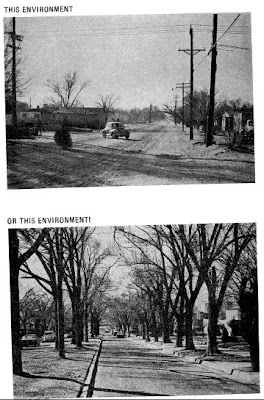Starting in junior high school, I became more and more interested in the problem of pollution, and in urban planning. Good planning can mitigate a lot of problems, and with my hometown of Albuquerque growing so rapidly, we had lots of problems, and we needed a lot of planning! So many developers, and so little time!
In high school, in response to the imperative of a school assignment, I went down to the Albuquerque City Planning Department, plus the offices of several land developers, and gathered materials for an opus regarding these issues.
My City Planning Report (dated April 29, 1973) was probably the most-important report I ever prepared in high school. It forecasts the trajectory of my entire life! It was even more important than my ginormous 7th-grade junior-high-school report on Nicaragua. I can't believe I got a "D" on it! Nevertheless, from a 21st-Century perspective, this high school report makes for interesting reading!
 Left: A picture from page 16 of "Albuquerque Community Renewal Program - Summary Report", prepared by the Albuquerque Planning Department (June, 1970).
Left: A picture from page 16 of "Albuquerque Community Renewal Program - Summary Report", prepared by the Albuquerque Planning Department (June, 1970).I like this picture. What kind of community do you want? You can have the first kind of community - a kind of Southwestern version of Pottersville. A proletarian Volkswagen crossing a dirt thoroughfare with no sidewalks and lined with crappy-looking salt cedar, rendered dusty by winds blowing a huge tumbleweed across it. Or you can have a Bedford Falls kind of place, like in the second picture. Well-watered, lots of cottonwood trees, with amenities like sidewalks and twittering birds. It's all about the planning!
In "Breaking Bad" terms, the first neighborhood is similar to where Combo lives, and the second is (literally) the neighborhood where Jesse Pinkman lives.
This document leaves out a few historical details, like why the second neighborhood is so nice. I don't know the facts myself, but if I had to guess, I'd say it wasn't because of the Albuquerque Planning Department's works, but because of the looming influence of Franz Huning on the second neighborhood's early development. Huning was determined not to live in a bad neighborhood, and he had the swag to push aside anything that didn't look like it fit. Huning's absence is keenly felt: Jesse Pinkman would have been drummed out of the neighborhood in minutes, back in the day! The role of bureaucratic structures like the Albuquerque Planning Department, of course, is to substitute for the beneficent influences of hard-driving patrons of the sort that used to prevail in the 19th Century.
I'm not sure what the folks at the Albuquerque Planning Department made of the owl-eyed kid who showed up at their door one day, but they helpfully provided some glossy documents with impressive-looking flow charts (I particularly like the lush "Albuquerque/Bernalillo County Comprhensive Plan - Metropolitan Environmental Framework": April, 1972). I had the impression that, despite their title, they weren't really in the driver's seat when it came to urban planning in Albuquerque. The real urban planners, the people with the money, and the connections, and that vision thing, were the real estate developers: Falls Land and Development Corporation, Horizon Corporation, and OMIGOD!, the AMREP folks representing the Monstrosity on the Mesa, Rio Rancho! Already, by 1973, Rio Rancho was out-of-control, the land-eating equivalent of last year's Wallow Wildfire, but the documents show the Albuquerque Planning Department was curiously out-of-touch with those contemporary events, and barely-aware Rio Rancho even existed.
 Left: Two different estimates of future Albuquerque population. The bullish Kirschner Report (January, 1968: 'Bernalillo County Total Population Projections'), and the more-cautious UNM-COG (University of New Mexico - Middle Rio Grande Council of Governments) Special Report (April, 1973: APJ-1 District, medium population estimate). I wonder who won this particular contest?
Left: Two different estimates of future Albuquerque population. The bullish Kirschner Report (January, 1968: 'Bernalillo County Total Population Projections'), and the more-cautious UNM-COG (University of New Mexico - Middle Rio Grande Council of Governments) Special Report (April, 1973: APJ-1 District, medium population estimate). I wonder who won this particular contest? Here are the results, using U.S. Census data! APJ-1 District 1 incorporates urban Albuquerque, Bernalillo, Los Lunas, and Belen, so its population is roughly-equivalent to that of Bernalillo County. Census figures (from Wikipedia) are compared to the past estimates. Even though the UNM-COG medium population estimate looks slightly-low, it is still far better than the overly-optimistic Kirschner report's estimate. UNM-COG rules!
Here are the results, using U.S. Census data! APJ-1 District 1 incorporates urban Albuquerque, Bernalillo, Los Lunas, and Belen, so its population is roughly-equivalent to that of Bernalillo County. Census figures (from Wikipedia) are compared to the past estimates. Even though the UNM-COG medium population estimate looks slightly-low, it is still far better than the overly-optimistic Kirschner report's estimate. UNM-COG rules!I think a lot of people in the 1960's were bedazzled by the growth of Southern California, and Phoenix, and figured the same thing would happen in Albuquerque too. But as I've written elsewhere, Albuquerque is a place that tends to attract impractical dreamers, who start can't-fail businesses that nevertheless fail, or who plan to have lots of kids who somehow never materialize. So, I can't be too hard on the Kirschner folks for their erroneous optimism!
 There are number of interesting figures in "The Development Potential of Albuquerque", Albuquerque/Bernalillo County Planning Department, October, 1972. Here is Figure 9, showing the degree of Health Planning. Zone 1 shows where "Health Service Generally Accessible To Population". Zone 2 shows "Inaccessible Or Ineffective Utilization Of Health Services". In Zone 1, people eat three square meals a day, get their vaccinations, and work out regularly. In contrast, Zone 2 is a place of medieval chaos, where diseased children squabble with pigs and dogs over scraps of bread in squalid, filthy courtyards. (Guess which zone I hail from?).
There are number of interesting figures in "The Development Potential of Albuquerque", Albuquerque/Bernalillo County Planning Department, October, 1972. Here is Figure 9, showing the degree of Health Planning. Zone 1 shows where "Health Service Generally Accessible To Population". Zone 2 shows "Inaccessible Or Ineffective Utilization Of Health Services". In Zone 1, people eat three square meals a day, get their vaccinations, and work out regularly. In contrast, Zone 2 is a place of medieval chaos, where diseased children squabble with pigs and dogs over scraps of bread in squalid, filthy courtyards. (Guess which zone I hail from?). Here is Figure 11 in "The Development Potential of Albuquerque", showing the degree of Emergency Preparedness. Zone 1 is the most adequately prepared. Zone 2 isn't so bad. Zone 3, you're gonna die! (Guess which zone I hail from?)
Here is Figure 11 in "The Development Potential of Albuquerque", showing the degree of Emergency Preparedness. Zone 1 is the most adequately prepared. Zone 2 isn't so bad. Zone 3, you're gonna die! (Guess which zone I hail from?) Here is Figure 66 from the Albuquerque Transportation Study, Wilbur Smith and Associates (May, 1965) showing their idea of where the major roads would be placed in the future.
Here is Figure 66 from the Albuquerque Transportation Study, Wilbur Smith and Associates (May, 1965) showing their idea of where the major roads would be placed in the future.Interestingly, most of these projections came to pass: Montano Road's expansion, in particular, which I felt was an affront to my sense of how the city should be run when I was a teenager. The forecast missed the full importance of the El Pueblo (Paseo del Norte) and 98th/Ouray corridors, and gave too much weight to the Wyoming Boulevard corridor, and brought El Pueblo in contact with Eubank instead of Tramway (which they call Panorama), and they missed the Rio Rancho connections entirely (per usual for the planners in the 60's), but, by and large, these forecasts came to pass.
There are other hints of the future in these reports. In the "Albuquerque Community Renewal Program - Summary Report" there are recommendations made by Architect and Urban Planner David A. Crane of Philadelphia recommending that Albuquerque expand its number of "collective environments". Two of these three recommendations - a technical-vocational center, together with a sub-regional shopping center, at Osuna and I-25, and a recreational/cultural center near Tingley Park and the Zoo, came to pass. The third: an educational/public services complex in the Model Neighborhood area doesn't seem to have come to fruition, but similar complexes are nearby.
Just as the Albuquerque of 2012 is hazily visible in the planning documents of 1973, the Albuquerque of 2050 is likely hazily visible in the planning documents of today!
This is a great report I wrote! Why did I get a "D"?
Interestingly enough, I wrote some revealing information into the report:
This report was written under bad circumstances. We had three weeks to complete it, but I was unable to get information on it until the last week. It was necessary to get an extension to complete it to my satisfaction(?) The haste in which it was written and the bad lighting conditions under which it was written have caused terminal writer's cramp and nearly illegible handwriting, as you may have noticed (hee-hee!)Well, that explains it, I guess. No wonder I got a "D"! That's the science training in me: compulsively-honest, even when it did me no good. If this report was done for Humanities class it was completely at odds with the instructor's wishes: data-driven, when he was looking for feelings instead. Getting indulgences and extensions from the teacher worked in the 7th-grade, but 11th grade was different.
Still, it's a great report! I can't believe I got a "D" on it!
No comments:
Post a Comment